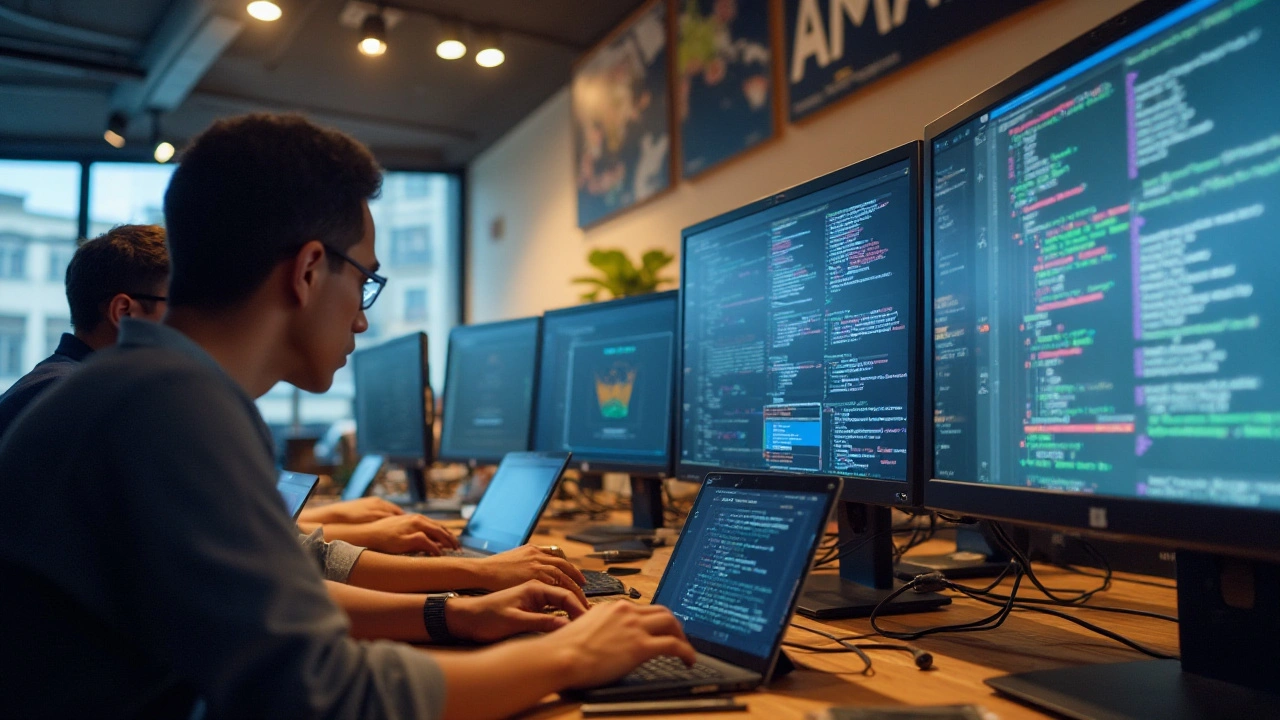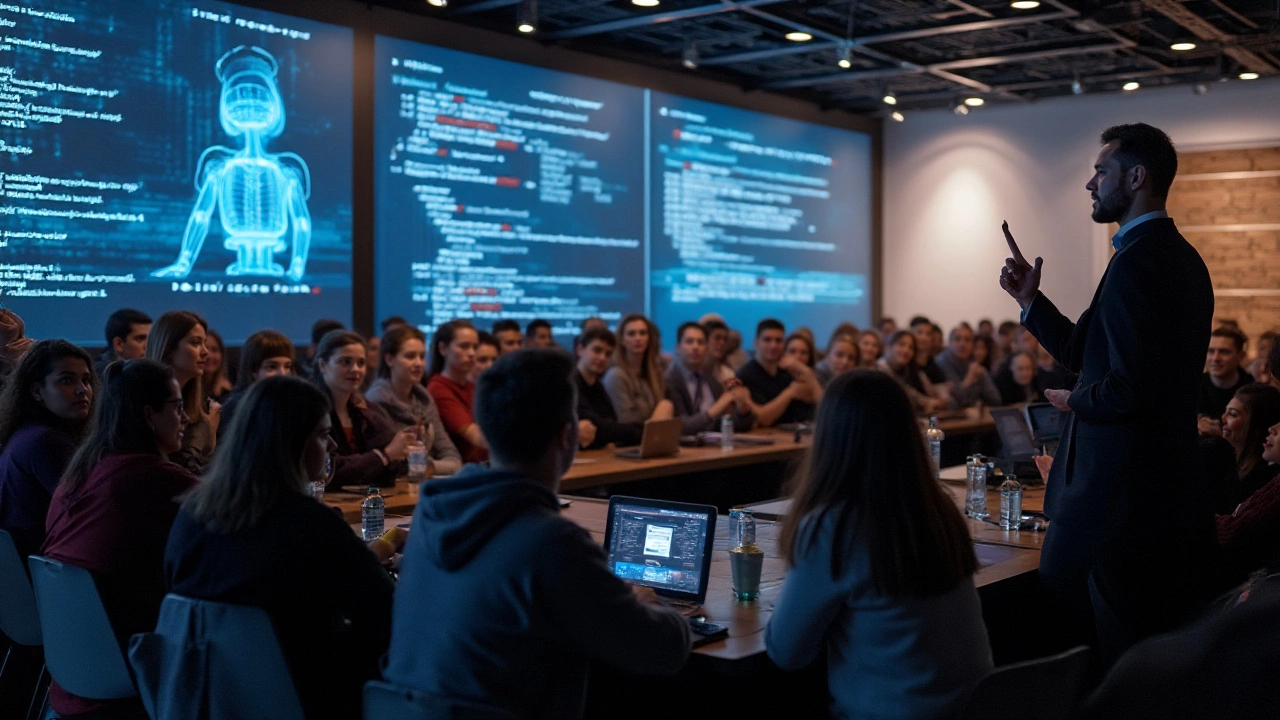Mastering AI Coding: Essential Skills for Modern Tech Professionals

In a rapidly evolving world where technology continually pushes boundaries, the role of coding in artificial intelligence (AI) stands out as particularly vital. Crafting the brains behind robots, personal assistants, and data-driven algorithms, mastering AI coding is now an indispensable skill for today's tech professionals.
Diving into AI coding involves understanding a few essential programming languages, familiarizing oneself with core techniques, and recognizing the real-world implications of these technologies. With AI shaping everything from healthcare to entertainment, knowing how to code for these systems is more relevant than ever.
- Introduction to AI Coding
- Key Programming Languages
- Fundamental Techniques
- Real-world Applications
- Continuous Learning
Introduction to AI Coding
The world of artificial intelligence has quickly transcended the realm of science fiction, firmly rooting itself as a pivotal component of our everyday lives. From self-driving cars to smart assistants like Alexa and Siri, AI is everywhere, and it all starts with coding. But what exactly does coding for AI entail? To begin with, it's essential to understand that AI coding involves creating algorithms that can learn and adapt. Unlike traditional programming where rules are explicitly defined, AI coding empowers systems to develop their own rules based on data.
The enthusiasm for coding doesn't solely come from its innovative capacity, but also from the substantial impact it's having across different industries. In healthcare, AI technology is being used to predict patient outcomes, thereby providing better treatment plans. In finance, AI algorithms can analyze market trends and suggest investments. One cannot overstate the importance of mastering coding for AI when considering its vast applications. Dr. Andrew Ng, a prominent figure in AI, puts it succinctly:
“AI is the new electricity. Just as electricity transformed many industries starting about 100 years ago, AI will also now transform nearly every major industry.”This highlights the revolutionary potential of AI and underscores the value of getting skilled in its coding practices.
Coding for AI is not just about knowing a single language or following a rigid process. It's about understanding the principles behind machine learning, neural networks, and natural language processing, among others. For instance, those diving into this field often start with Python since it offers simplicity and extensive libraries suited for AI development. Languages like R and Java also hold their ground significant importance. Professionals are often encouraged to explore multiple languages to find what works best for their specific needs.
Let's not forget the necessity of being comfortable with data. Data is the backbone of AI, and without it, algorithms have nothing to learn from. Thus, anyone looking to master AI coding must also understand data handling, cleaning, and preprocessing. In essence, it's not just about writing code but about curating the data that will breathe life into the AI.
If one were to glance at the job market, the need for professionals skilled in AI coding becomes immediately apparent. According to a report by LinkedIn, roles in artificial intelligence have grown 74% annually in the past four years. This speaks volumes about the demand and also highlights the lucrative opportunities available for those possessing these specialized skills.
Moreover, AI projects often begin with identifying a problem that AI can solve or a process that can be optimized. This involves a fair amount of brainstorming, research, and often collaboration with cross-functional teams. The process typically follows these steps:
- Define the problem clearly.
- Gather and preprocess data.
- Select and train the model.
- Evaluate the model's performance.
- Deploy the model and monitor its effectiveness.
It is clear that coding for AI is not just about the technical skills, but also about critical thinking and problem-solving.
In summary, AI coding is a multifaceted skill set that extends beyond just knowing how to write algorithms. It involves understanding the languages of AI, being adept with data, and aligning technical expertise with strategic thinking to solve real-world problems. With its growing impact across various sectors, gaining proficiency in AI coding is a smart move for anyone looking to thrive in the modern tech landscape.
Key Programming Languages
The world of coding for AI is vast, but there are a few standout programming languages that every aspiring tech professional should know. These languages form the backbone of AI development, enabling the creation of smart algorithms, data processing, and learning from vast datasets.
First on the list is Python. Known for its simplicity and readability, Python has become the go-to language for AI programming. Its rich ecosystem of libraries, like TensorFlow and PyTorch, makes the implementation of complex AI algorithms more accessible. Python's versatility and ease of learning have made it popular among both beginners and experienced developers. According to the TIOBE Index, Python has consistently ranked among the top programming languages for several years.
Python is to AI what a hammer is to carpentry. Without it, you’d really struggle to make things work. - Michael Nguyen, AI Researcher
Another crucial language for AI coding is R. While primarily used for statistical analysis and data visualization, R's strengths lie in its ability to handle large datasets and complex numerical problems. It's heavily utilized in academic research and by data scientists who need to delve deep into data analysis. R's comprehensive packages, such as caret and mlr, provide tools for machine learning, making it a valuable asset in the AI developer's toolkit.
Next up is Java, a powerful language known for its performance and scalability. Java is widely used in enterprise settings where scalability and maintainability are crucial. For AI applications that require handling large-scale data processing or integrating with other enterprise systems, Java is often the language of choice. Its ecosystem, including frameworks like Deeplearning4j, makes building and deploying complex AI models more manageable.
Java’s robustness in enterprise environments makes it a reliable choice for AI development where performance is non-negotiable. - David Brown, Software Engineer
We also have C++. While it’s known for being a bit more challenging to learn, it offers significant advantages in terms of performance. In AI development, especially for projects requiring high-performance computation, C++ shines. It’s commonly used in developing real-time AI applications such as video games, where speed is critical. Libraries such as TensorRT optimize neural network inference in deployment, making C++ an indispensable tool.
Lastly, JavaScript is emerging as an important language in the AI realm, particularly for building web-based AI applications. With libraries like TensorFlow.js, developers can create and train AI models directly in the browser. This opens the door to interactive AI applications that run in a web environment, enhancing user experiences and accessibility.
Understanding these languages and their specific strengths can significantly impact your effectiveness as an AI coder. Each language offers unique benefits and is suited for various aspects of AI development. Learning and mastering these key programming languages will put you in a strong position to tackle the exciting challenges of the AI-driven future.

Fundamental Techniques
Understanding the fundamental techniques in AI coding is crucial for any budding tech professional. The journey begins with learning to handle large datasets, a core aspect of any AI project. Data is the lifeblood of AI, and having the skills to clean, process, and analyze it can set you apart in the industry. Python is often the go-to language for this purpose, thanks to its simplicity and the comprehensive range of libraries like Pandas and NumPy, which make data manipulation straightforward.
Once you've mastered data handling, the next step is to get comfortable with creating and training machine learning models. This involves understanding algorithms like linear regression, decision trees, and neural networks. Tools such as TensorFlow and PyTorch can help you build these models from scratch. They offer extensive documentation and community support, making the learning curve less steep. “Machine learning is not just learning from data; it's learning from massive datasets,” says Andrew Ng, a pioneer in machine learning.
Another key aspect of AI coding is natural language processing (NLP). With technologies like chatbots and virtual assistants becoming part of our daily lives, understanding NLP is almost a prerequisite. Libraries like NLTK and spaCy can provide the tools you need to work with text data, understand syntax, and implement language-based algorithms. This can be particularly engaging when you're working on projects like sentiment analysis, language translation, and voice recognition.
Don't overlook the importance of deep learning techniques, which have revolutionized fields like computer vision and speech recognition. Convolutional neural networks (CNNs) and recurrent neural networks (RNNs) are essential for anyone looking to specialize in these areas. These networks mimic the way the human brain processes information, making them highly effective for complex tasks like image and video analysis. Frameworks like Keras and TensorFlow make implementing these networks more accessible, even for those new to the field.
Model evaluation and optimization are also critical components. Knowing how to assess the performance of your AI models using metrics like accuracy, precision, recall, and F1 score can help you refine and improve your solutions. Techniques such as cross-validation and hyperparameter tuning can significantly enhance the efficacy of your models.
Finally, ethical considerations and understanding bias in AI are becoming increasingly important. As AI systems become more integrated into our daily lives, ensuring they're designed and trained ethically is crucial. Being aware of potential biases and taking steps to mitigate them can make your AI solutions more robust and fair.
Real-world Applications
When it comes to coding for AI, the most exciting aspect might be seeing how these technologies come to life in various industries. AI has found its way into countless sectors, significantly transforming the way businesses and services operate. From healthcare and finance to entertainment and logistics, AI's real-world applications are broad and continually expanding.
In healthcare, for instance, AI has revolutionized diagnostics and patient care. AI algorithms can analyze medical images with high precision, identifying potential issues that might be missed by human eyes. Additionally, AI-driven applications assist in maintaining patient records, predicting disease outbreaks, and offering personalized treatment plans. The accuracy and speed brought by AI in medical diagnosis have been described as game-changers in the field. In fact, a 2020 study in The Lancet Digital Health found that AI systems were as accurate as human experts in interpreting medical images.
The finance sector has also seen massive improvements thanks to AI. Banks and financial institutions use AI to detect fraudulent activities, offer customer support via chatbots, and manage portfolios. AI systems can process and analyze vast amounts of data in seconds, providing insights and predictions that help in risk management and investment strategies. A notable example is JPMorgan Chase's COiN program, which saves over 360,000 hours of annual labor by interpreting commercial-loan agreements using machine learning techniques.
In the world of entertainment, AI has changed how we consume media and interact with content. Streaming services like Netflix and Spotify use AI algorithms to recommend shows, movies, and music based on user preferences. These recommendations are not only based on what users have watched or listened to in the past but also consider broader viewing and listening trends. This personalized approach keeps users engaged and enhances their overall experience. A report by McKinsey noted that 75% of what users watch on Netflix is driven by the platform's recommendation system.
Logistics and supply chain management have also benefited immensely from AI. Companies like Amazon and DHL use AI to optimize routes, manage inventory, and predict demand. AI-driven systems can analyze weather patterns, traffic conditions, and various logistical challenges to find the most efficient delivery routes. This not only reduces delivery times but also cuts costs and lowers carbon emissions, making operations more sustainable. The efficiency gains here are considerable; for example, UPS uses AI to save up to 10 million gallons of fuel annually by optimizing delivery routes.
"The real promise of artificial intelligence lies not in what it can do alone, but in how it can be combined with human capabilities to produce superior outcomes," remarked James Manyika, Chairman of the McKinsey Global Institute.
Indeed, the diverse real-world applications of AI underscore its importance in modern tech careers. As businesses and industries continue to adopt these technologies, the demand for skilled professionals who can develop and implement AI solutions will only grow. The impact of AI is vast, touching every aspect of our daily lives and making a profound difference in the way we live and work.

Continuous Learning
The tech world is in a perpetual state of flux, and the field of AI is no exception. For tech professionals aiming to stay at the forefront of their careers, continuous learning is not merely an option but a necessity. Given the rapid advancements in artificial intelligence, this constant evolution demands that professionals keep themselves updated with the latest trends, techniques, and technologies.
One effective way to stay current is through online courses and certification programs. Websites like Coursera, edX, and Udacity offer specialized courses in AI and related fields. These platforms provide not just theoretical knowledge but practical, hands-on experience as well. For instance, Google's AI for Everyone program is designed to demystify artificial intelligence for the masses, making it easier for professionals to grasp the basics and build on this foundation.
Attending workshops, webinars, and conferences is another vital aspect of continuous learning. These events offer a platform for professionals to network, exchange ideas, and learn from experts in the industry. The annual Neural Information Processing Systems (NeurIPS) conference, for instance, hosts a wide array of presentations and workshops, providing invaluable insights into the latest AI research and applications. Engaging with such forums can significantly enhance one's understanding and skills in AI coding.
Reading is equally important. Books like 'Artificial Intelligence: A Modern Approach' by Stuart Russell and Peter Norvig offer comprehensive insights into the field. Subscribing to journals and magazines, such as the Journal of Artificial Intelligence Research, provides access to the latest studies and developments. Staying updated with recent publications ensures that professionals are aware of the emerging trends and can adapt their skills accordingly.
Joining professional communities and forums can also be highly beneficial. Platforms like GitHub, Stack Overflow, and Reddit's r/MachineLearning offer interactive spaces where professionals can pose questions, share solutions, and discuss new ideas. Engaging with these communities helps in gaining different perspectives and learning new problem-solving approaches.
"The beautiful thing about learning is that nobody can take it away from you." — B.B. KingLastly, practical experience is a critical component of continuous learning. Working on real-world projects, contributing to open-source projects, or even starting personal projects can provide hands-on experience that theoretical knowledge alone cannot. Such practical applications allow professionals to test and refine their skills, making them more adept at tackling real-world problems.
In essence, the key to becoming proficient in coding for AI lies in the willingness and commitment to keep learning. Continuous learning is the bridge that connects theoretical knowledge with practical experience, ensuring that tech professionals remain relevant and competitive in an ever-evolving industry.